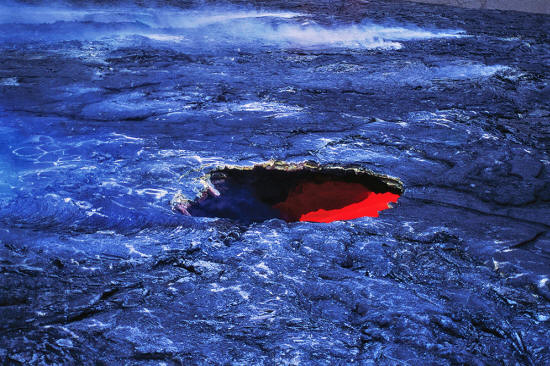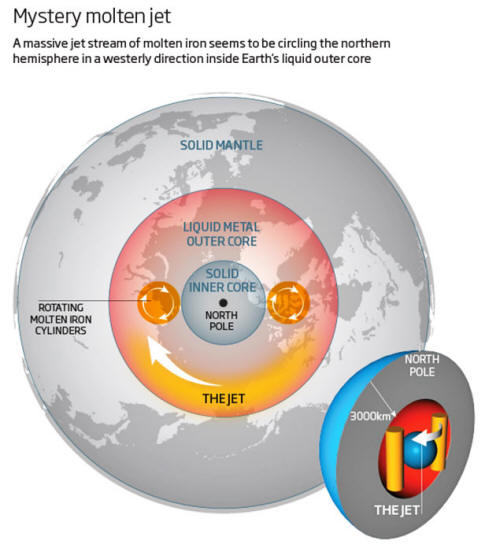|
by Andy Coghlan 19 December 2016
from
NewScientist Website
That is three times
faster than typical speeds of liquid in the outer core.
Straight to the core
What made the discovery possible was the combined monitoring power of the European Space Agency's trio of satellites, called Swarm, which were launched in 2013.
From orbit, they can measure magnetic field variations as deep down as 3000 kilometers below Earth's surface, where the molten core meets the solid mantle.
Plugging the new data into models also allowed the team to figure out how the fluctuations changed over time.
Invisible river
Earth's magnetic field is generated by the movement of molten iron in the outer core, so examining the magnetic field can reveal details of the behavior of the core that underpins it.
The discovery of the jet involved tracking two massive but unusually strong lobes of magnetic flux originating from the core-mantle boundary, situated beneath Canada and Siberia respectively, but moving with the flow of the molten iron.
Because their motion could originate only from the physical movement of molten iron, the lobes served as markers, allowing the researchers to track the flow of iron.
Livermore likens it to being able to track the course of a river at night by watching candles floating on the surface.
He says there may be a southern counterpart to the jet, but because there are no trackable flux lobes in the south, any magma stream there can't be picked up geomagnetically.
Rotating cylinders
Livermore and his colleagues say the jet is created by movement of molten iron around the inner, solid iron core.
Next to the inner core, there are parallel cylinders of swirling molten iron in the outer core running from north to south. Where these swirling cylinders meet the solid core, and squash against it, they act like a pair of rollers, squeezing out additional molten iron sideways to create the jet stream.
This produces and moves the two lobe-like magnetic fields, which is what the satellites detected and tracked.
Why the jet is getting faster is more of a mystery. It may be related to the rotation of the inner core, which was found in 2005 to rotate a bit faster than Earth's crust, says Xiaodong Song of the University of Illinois in Champaign, Illinois.
Xiaodong was a member of the team that used seismological data to make that 2005 discovery.
Livermore thinks the acceleration of the jet is down to push-back from magnetic fields. The flow of iron generates the magnetic field, but, he says, the magnetic field may then be affecting the flow of the iron.
Studying the jet should enable geophysicists to better understand how the planet's core behaves, and the factors that influence Earth's magnetic field strength.
Flip the polarity
Other geophysicists agree.
Earth's magnetic field seems to have been weakening, especially since around 1840, at about 5 per cent per century.
The magma stream should help geophysicists predict more accurately if and when the magnetic field of the planet's core will flip, and the magnetic north and south poles trade places, which happens every few hundred thousand years.
And thanks to the satellite monitoring system, says Xiaodong, we have now opened a new window to view in "real time" the activity of molten iron deep in Earth's core.
Reference
|



